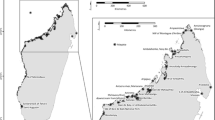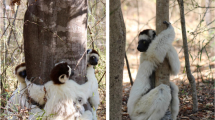Abstract
Lemur catta Troop D at Berenty Reserve has been studied intermittently for 35 years. During 90 hours of continuous sampling in August 1998, I observed and mapped troop movement and scent marking. I compared these observations with data from June, 1975. The core of Troop D1's 1998 home range is the same as for Troop D in 1975. Sixty-two percent of Troop D1's time in 1998 was spent in the 1975 home range, and 52% of their scent marks were placed in that 1975 home range. The remainder of their time was spent in an extension of their home range, which is now an area of confrontation with an adjacent troop. They used the same sleeping trees in the 2 years, and all of the 1998 scent marks deposited in the 1975 home range were placed in the same locations marked in 1975. The similarities in their use of space in 1975 and 1998 were remarkable.
Similar content being viewed by others
REFERENCES
Brownikowski, A. A., and Altmann, J. (1999). Foraging in a variable environment: Weather patterns and the behavioral ecology of baboons. Behav. Ecol. Sociobiol. 39: 11-25.
Budnitz, N. and Dainis, K. (1975). Lemur catta: Ecology and behavior. In Lemur Biology. Tattersall, I., and Sussman, R. W. (eds.), New York, Plenum: 219-235.
Ganzhorn, J. U. (1995). Low-level forest disturbance effects on primary production, leaf chemistry, and lemur populations. Ecology 76(7): 2084-2096.
Gould, L. (1996). Male-female affiliative relationships in naturally occurring ring-tailed lemurs (Lemur catta) at the Beza Mahafaly Reserve, Madagascar. Amer. J. Primatol. 39: 63-78.
Gould, L. (1997). Intermale affiliative behavior in ring-tailed lemurs (Lemur catta) at the Beza-Mahafaly Reserve, Madagascar. Primates 38: 15-30.
Gould, L., Sussman, R. W., and Sauther, M. L. (1999). Natural disasters and primate populations: The effects of a 2-year drought on a naturally occurring population of ring-tailed lemurs (Lemur catta) in southwestern Madagascar. Int. J. Primatol. 20: 69-84.
Hood, L. C., and Jolly, A. (1995). Troop fission in female Lemur catta at Berenty Reserve, Madagascar. Int. J. Primatol. 16(6): 997-1016.
Howarth, C. J., Wilson, J. M., Adamson, A. P., Wilson, M. E., and Boase, M. J. (1986). Population ecology of the ring-tailed lemur, Lemur catta, and the white sifaka, Propithecus verreauxi verreauxi, at Berenty, Madagascar, 1981. Folia Primatol. 47: 39-48.
Jolly, A. (1966) Lemur Behavior. Chicago, Univ. Chicago Press.
Jolly, A. (1972). Troop continuity and troop spacing in Propithecus verreauxi and Lemur catta at Berenty (Madagascar). Folia Primatol. 17: 335-362.
Jolly, A., Oliver, W. L. R., and O'Connor, S. M. (1982). Population and troop ranges of Lemur catta and Lemur fulvus at Berenty, Madagascar: 1980 Census. Folia primatol. 39: 115-123.
Jolly, A., and Pride, E. (1999). Troop histories and range inertia of Lemur catta at Berenty, Madagascar: A 33-year perspective. Int. J. Primatol. 20: 359-373.
Jolly, A., Rasamimanana, H. R., Kinnaird, M. F., O'Brien, T. G., Crowley, H. M., Harcourt, C. S., Gardner, S., and Davidson, J. M. (1993). Territoriality in Lemur catta groups during the birth season at Berenty, Madagascar. In Lemur Social Systems and Their Ecological Basis. Kappeler, P. M., and Ganzhorn, J. U. (eds.), New York, Plenum: 85-109.
Jones, K. D. (1983). Intertroop transfer of Lemur catta males at Berenty, Madagascar. Folia Primatol. 40: 145-160.
Kappeler, P. M. (1998). To whom it may concern: The transmission and function of chemical signals in Lemur catta. Behav. Ecol. Sociobiol. 42(6): 411-421.
Kappeler, P. M., and Ganzhorn, J. U. (1993). The evolution of primate communities and societies in Madagascar. Evol. Anthropol. 2(5): 159-171.
Klopfer, P. H., and Jolly, A. (1970). The stability of territorial boundaries in a lemur troop. Folia Primatol. 12: 199-208.
Koyama, N. (1991). Troop division and inter-troop relationships of ring-tailed lemurs (Lemur catta) at Berenty, Madagascar. In Primatology Today. Ehara, A., Kimura, T., Takenaka, O., and Iwamoto, M. (eds.), Amsterdam, Elsevier: 173-176.
Leigh, S. R., and Terranova, C. J. (1998) Comparative perspectives in bimaturism, ontogeny, and dimorphism in lemurid primates. Int. J. Primatol. 19(4): 723-749.
Martin, P., and Bateson, P. (1993). Measuring Behaviour. An Introductory Guide (2nd ed.). New York, Cambridge University Press.
Mertl, A., S. (1977). Habituation to territorial scent marks in the field by Lemur catta. Behav. Biol. 21: 500-507.
Mertl-Millhollen, A. S. (1988). Olfactory demarcation of territorial but not home range boundaries by Lemur catta. Folia Primatol. 50: 175-187.
Mertl-Millhollen, A. S., Gustafson, H. L., Budnitz, N., Dainis, K., and Jolly, A. (1979). Population and territory stability of the Lemur catta at Berenty, Madagascar. Folia Primatol. 31: 106-122.
Millhollen, A. (1986). Territorial scent marking by two sympatric lemur species. In Chemical Signals in Vertebrates 4. Duvall, D., Müller-Schwarze, D., and Silverstein, R. M. (eds.), New York, Plenum: 647-652.
O'Connor, S. M. (1987). The effect of human impact on vegetation and the consequences to primates in two riverine forests, southern Madagascar. Dep't of Applied Biology. Cambridge, Cambridge University, PhD Thesis: 327 pp.
Rasamimanana, H., and Rafidinarivo, E. (1993). Feeding behavior of Lemur catta females in relation to their physiological state. In Lemur Social Systems and Their Ecological Basis. Kappeler, P. M., and Ganzhorn, J. U. (Eds.), New York, Plenum: 123-133.
Sauther, M. L. (1993). Resource competition in wild populations of ring-tailed lemurs (Lemur catta): Implications for female dominance. In Lemur Social Systems and Their Ecological Basis. Kappeler, P. M., and Ganzhorn, J. U. (eds.) New York, Plenum: 135-152.
Sauther, M. L., and Sussman, R. W. (1993). A new interpretation of the social organization and mating system of the ring-tailed lemur (Lemur catta). In Lemur Social Systems and Their Ecological Basis. Kappeler, P. M., and Ganzhorn, J. U. (eds.), New York, Plenum: 111-121.
Sauther, M. L. (1998). Interplay of phenology and reproduction in ring-tailed lemurs: Implications for ring-tailed lemur conservation. Folia Primatol. 69(suppl. 1): 309-320.
Schilling, A. (1974). A study of marking behaviour in Lemur catta. In Prosimian Biology. Martin, R. D., Doyle, G. A., and Walker, A. C. (eds.), Pittsburgh, Univ. of Pittsburgh Press: 347-362
Solberg, P., Dobson, A. P., and Jolly, A. (1996). Artificial provisioning and the impact of tourists on the population dynamics of ring-tailed lemurs at Berenty Reserve, Madagascar. Bull. Ecol. Soc. Amer. 77(suppl. pt 2): 416.
Sussman, R. W. (1991). Demography and social organization of free-ranging Lemur catta in the Beza Mahafaly Reserve, Madagascar. Am. J. Phys. Anthropol. 84: 43-58.
Sussman, R. W. (1992). Male life history and intergroup mobility among ringtailed lemurs (Lemur catta). Int. J. Primatol. 13: 395-413.
Rights and permissions
About this article
Cite this article
Mertl-Millhollen, A.S. Tradition in Lemur catta Behavior at Berenty Reserve, Madagascar. International Journal of Primatology 21, 287–297 (2000). https://doi.org/10.1023/A:1005429621566
Issue Date:
DOI: https://doi.org/10.1023/A:1005429621566




